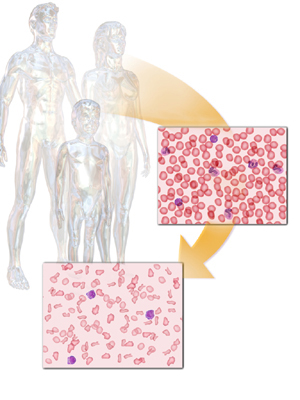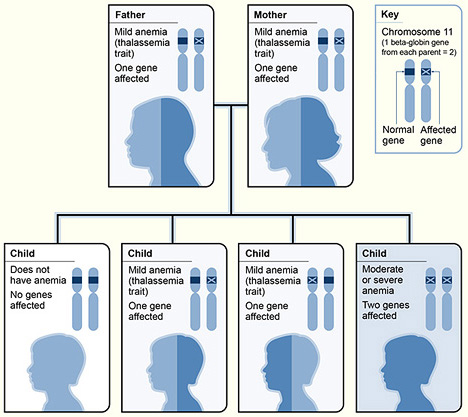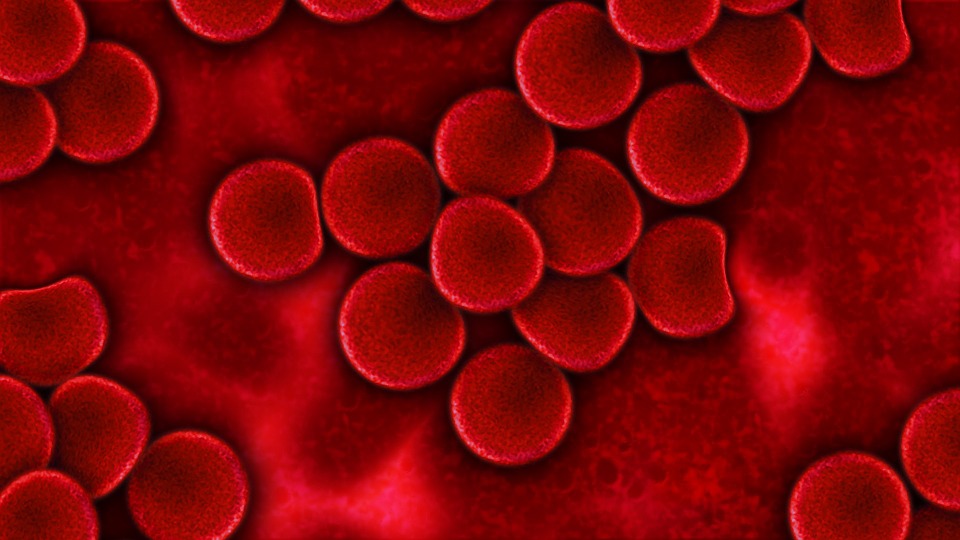Some people dream of winning a marathon. These people are usually the type who loves running and are able to train themselves to be able to run the full 26 miles. For some, this is nearly impossible as their body, more specifically, their blood will not let them. This is the case for people, like myself, with thalassemia.
Thalassemia is an inherited (autosomal recessive pattern) blood disorder in which the body has a mutated form of hemoglobin. Hemoglobin alterations or deletions are caused by mutations in the globin genes from the chromosome 11. Thalassemia could result in destruction of red blood cells which causes anemia, having low red blood cell count or having low hemoglobin in the blood. There are three forms of thalassemia: alpha thalassemia, beta thalassemia, and thalassemia minor. Alpha and beta thalassemia has different subtypes which dictate the severity of the symptoms.

Normal red blood cells (top) compared thalassemia red blood cells (bottom)
By BruceBlaus [CC BY-SA 4.0

Inheritance pattern of thalassemia (autosomal recessive)
By National Heart Lung and Blood Institute (NIH) (National Heart Lung and Blood Institute (NIH)) [Public domain]
Symptoms of thalassemia:
- Bone deformities – thalassemia can result in expansion of the bone marrow
- Dark urine – caused by the bilirubin from broken down red blood cells
- Delayed growth and development – anemia could result in slowing of growth
- Excessive tiredness and fatigue – from the lack of oxygen circulating in the body
- Yellow or pale skin – also caused by anemia
Beta thalassemia
Beta thalassemia occurs when the body cannot produce beta globin because both beta globin genes (one from each parent) are missing. To inherit beta thalassemia, both parents must be carriers of the mutation. Beta thalassemia has two subtypes: thalassemia major or Cooley’s anemia and thalassemia intermedia. Of the two, thalassemia major is more severe and could be life-threatening. Patients with thalassemia major generally require regular blood transfusions.
Signs and symptoms of thalassemia major:
- fussiness
- paleness
- frequent infections
- a poor appetite
- failure to thrive
- jaundice, which is a yellowing of the skin or the whites of the eyes
- enlarged organs
In thalassemia intermedia, both globin genes are present but altered. This makes it less severe than thalassemia major and patients with the disease don’t require blood transfusions.
Alpha thalassemia
Each parent contribute two alpha globin genes to their offspring. Alpha thalassemia occurs if any of these four are missing disabling the body from producing alpha globin. Similar to beta thalassemia, alpha thalassemia also has two types: hemoglobin H and hydrops fetalis.
Hemoglobin H is characterized by three alpha globin genes missing or altered. This is the form of thalassemia that can cause bone deformities. Hemoglobin H disease can also have these symptoms:
- jaundice
- an extremely enlarged spleen
- malnourishment
The other form of alpha thalassemia which occurs in fetuses and caused by all four alpha globin genes missing or altered. Individuals with hydrops fetalis are either stillborn or die shortly after birth.
Diagnosis and Treatment
To diagnose thalassemia, doctors would take a blood sample to be tested. In the lab, the technician would check for anemia and hemoglobin levels. Additionally, the shape of the red blood cells would also be examined under a microscope to check for shape abnormality, a sign of thalassemia. For my experience, my thalassemia was discovered from a blood test done after my appendectomy.
The treatment used for thalassemia varies from each form and subtype. Some treatments used today are:
- blood transfusions
- bone marrow transplant
- medications and supplements
- possible surgery to remove the spleen or gallbladder
Thalassemia and Athletics
Since thalassemia causes alterations in the hemoglobin, which cells use to carry oxygen, an athlete with thalassemia would be at a disadvantage compared to a person with normal globin genes. Disadvantage could include much weaker muscle endurance and in some cases in the more serious form of thalassemia, physical activities could cause serious injuries or potentially be fatal. A person with any form of thalassemia will present symptoms of anemia. In thalassemia minor, individuals who possess this trait display minimal symptoms, if any. This would result in the patient being able to participate in athletic activities without any serious consequences. Individuals with alpha or beta thalassemia, however, would be a different case. Individuals with this form of thalassemia would be in risk of iron accumulation in the body. As a result, patients with alpha or beta thalassemia would most likely not be able to participate in athletic activities. Though athletic activities could be fatal and near impossible with some forms of thalassemia, there are still very determined individuals who did not let their conditions get in the way of their dreams. Some examples are:
Ben Li – a man with beta thalassemia major who ran the New York City Marathon in December 15, 2011. He took almost five hours to complete the 26.2mile run which is an amazing accomplishment considering his condition.
Pete Sampras – a retired professional tennis player that has beta thalassemia minor and is regarded as one of the greatest in the history of the sport.
Zinedine Zidane – a French professional soccer player who has thalassemia minor and now a manager of Real Madrid.
Of course, because of their conditions, these athletes needed to train harder compared to others who do not have thalassemia, especially for Ben Li, who has the more severe form of the condition. Additionally, they would have been monitored constantly by doctors ensuring they are safe in their activities.


Recent Comments